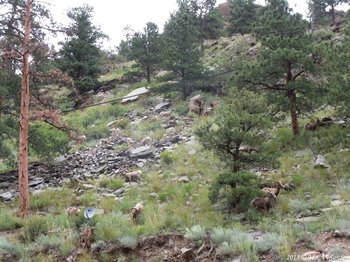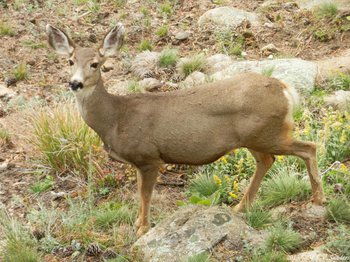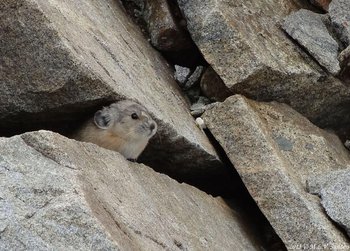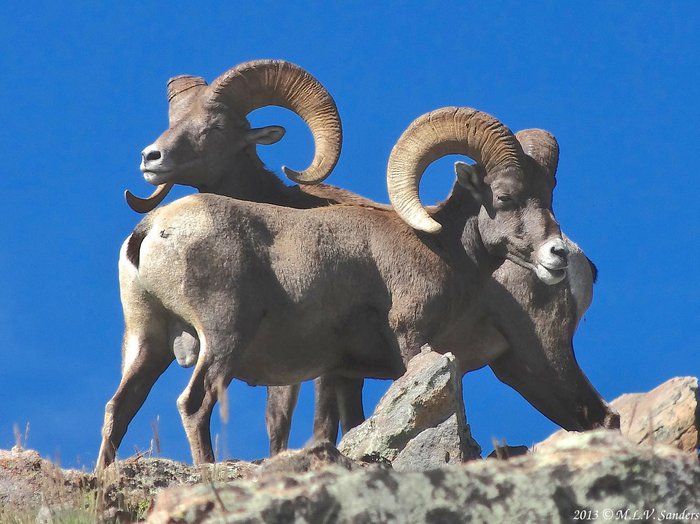Mammals of the Mountains
Aug. 17, 2021
revised: April 2, 2022

![Two bighorn rams on Twin Sisters in Rocky Mountain National Park]()
![Two bighorn rams on Twin Sisters in Rocky Mountain National Park]()
Two bighorn rams on Twin Sisters in Rocky Mountain National Park
My wife has been vacationing in Rocky Mountain National Park (RMNP) since the early 1960's when she was three years old. She has always been a keen observer of the wildlife in the mountains. But it has only been in the last ten years or so she has been able to take much better pictures of the wildlife because of the improvements in cameras that became affordable and easy to carry on long hikes.
Most photographs on this page were taken in RMNP, with some of them taken in the Indian Peaks to the south.
Bighorn Sheep
Some of the places where we have seen bighorn in RMNP over the years are Specimen Mountain, Lulu Mountain (by Thunder Pass), Trail Ridge, Twin Sisters, and in Big Thomson Canyon (where US 34 runs between Loveland and Estes Park). Bighorn are not common in RMNP and it is always a delight when the opportunity to see them presents itself.
All of the pictures below are of bighorn rams (males). Perhaps the ewes (females) are hiding.
My daughter and I, once took a summer hike to Thunder pass, Lulu Mountain and on to Thunder Mountain. In the early morning as we plodded our way up Lulu Mountain we noticed after a while that some of the distant boulders on the edge of Lulu Mountain, silhouetted in the early morning light, were not staying in the same place and appeared to be slowly moving. After careful observation we concluded these "moving boulders" were really bighorn ewes with lambs moving to maintain distance from us as we trudged along. It seems likely, that one reason we have rarely seen bighorn ewes with lambs in the summer is that they try to keep out of sight.

A group of bighorn rams grazing on Twin Sisters in RMNP just above the trail to the summit.

This bighorn ram was part of a group of rams we saw on Twin Sisters close to the trail.

Head on view of the head of a bighorn ram gazing down on us.

Two bighorn rams on Twin Sisters amongst the boulders.

Bighorn rams grazing below Trail Ridge Road. If there had been better light, this would have been a great picture.

Two bighorn rams by Trail Ridge Road.

A herd of bighorn rams that we saw when traveling on US 34 in Big Thompson Canyon. On close observation this wildlife photograph is marred by signs of civilization; a power and telephone lines run through the middle and a satellite dish is in the lower left.
Coyotes
There are a fair number of coyotes in Rocky Mountain National Park. we have been waken in the middle of the night by a group of yipping and howling coyotes while sleeping in our cabin at the YMCA of the Rockies, just outside the park. During daylight hours we usually only see individual coyotes all alone.

A coyote seen from Ute Trail West. It was leery and kept a eye on us.

The same coyote on Ute Trail West laying down with his paws stuck out front, watching us watching him. We have seen our collie take the same pose.
Elk

Elk grazing in Beaver Meadows in late May. They are very shaggy, shedding their winter coats. The second elk from the right sports a collar, probably for scientific study.

A herd of elk running through Beaver Meadows in late May.

An elk in Beaver Meadows in late May. His winter fur is shedding and the grass is starting to grow in dark green clumps; both signs of spring.

An elk antler laying on the ground near Beaver Meadows in late May. The park service prohibits the collection of antlers. They are part of the ecology. and provide a food source for small mammals.


An elk in Beaver Meadows.
Least Chipmunk

A least chipmunk feasting on the buds and flowers and of a currant bush.

Notice the distinctive white and dark brown stripes on the least chipmunks face and body. Least chipmunks can be distinguished from ground squirrels by these stripes on the face.
Moose
Moose (Alces alces), in the last 20 years or so have become increasingly common in and around Rocky Mountain National Park.

A large moose with impressive antlers leaving a tall thicket of willows next to Brainard Lake in the Indian Peaks south of Rocky Mountain National Park.

It is hard to completely hide a moose. In these dense willow bushes, a moose is hidden but its antlers protrude into the air.

A moose at Brainard Lake.
Mule Deer
Mule Deer (Odocoileus hemionus) are seen in Rocky Mountain National Park and the Indian Peaks, often in small groups.

A mule deer buck on the grounds of the YMCA of the Rockies.

A young mule deer near Pole Hill Road near the town of Estes Park. From this head-on view, the size of the ears are remarkable. One ear appears almost as large as the rest of the head.

Looking down on a mule deer.
Pika
Pika (Ochotona priceps) are one of my favorite sights when hiking in the higher elevations. These small, less than 8 inches long _1_, furry creatures are seen around large piles of rocks and boulders. They are often scurrying about but will pause their motion to strike some very interesting poses. They seem bold, not deterred by the presence of nearby hikers, perhaps because of the numerous cracks and crevices to hide in for safety.

A pika on the side of Trail Ridge Road not far above Rainbow Curve parking lot in late May. Trail Ridge road was not open past Rainbow Curve allowing us an easy stroll.

A pika peering out from the gap between two very large rocks. Pikas seem to thrive in fields of large boulders.

This pika has its cute feet where they can be seen. Pika prefer fields of rocks where the gaps between the rocks are wide enough to provide paths _1_.

An inconspicuous pika, as it is often seen by hikers, peering out from underneath a rock or boulder. They are well camouflaged in the boulder fields. Their high pitch eek or squeak is usually heard before they are seen.

In late May, a pika pauses in its scampering. The snow has recently melted. The grasses and forbs that it eats have yet to turn green.

An attentive pika on Ute Trail West.

Another pika on Ute Trail West with an interesting mottled coat of mostly brown and grey.
Snowshoe Hare
Snowshoe hares (Lepus americanus) are members of the rabbit family. In the gallery below, the snowshoe hares hold perfectly still, allowing for good photographs. But these hares are related to jack rabbits and are capable of great sudden bursts of speed.

A snowshoe hare in late May along the Bear Lake Trail sits next to a pile of snow left over from the winter. Its white coat with brown and gray splotches is the result of a gradual change from white in the winter to grayish-brown in the summer. The hind feet appear to be almost one half of the body length.

A completely still snowshoe hare seen along the side of Flattop Mountain Trail not far from Bear Lake. The hare is in the center bottom of the picture.

We were several feet away from this young snowshoe hare before we noticed it hiding under a small boulder along the Lookout Mountain Trail. The snowshoe hare kept perfectly still.
Yellow-bellied Marmot
The yellow-bellied marmot (Marmota flaviventris) is commonly found in Rocky Mountain National Park and along the Colorado front range from the montane to the alpine zones.

A yellow-bellied Marmot peering at passing hikers from behind a boulder on the Cub Lake trail.

Young marmots playing on a boulder next to the Cub Lake Trail in late May.

Marmots can be very photogenic. They will often sit still as though posing for a camera on highly visible rocks in the bright sunshine. Their posture and facial expressions at times look almost human.
This old marmot appears to be looking inquisitively over its shoulder, possibly at a passing hiker taking a photograph.

A marmot laying flat on a lichen covered boulder with its eyes wide open.
Wyoming Ground Squirrel
Wyoming ground squirrels (Spermophilus elegans) are common at elevations above 6000 ft_1_. They have a brownish gray coat with no stripes and a whitish to buff belly.

A Wyoming ground squirrel feasting outside of Hyde Chapel on the grounds of the YMCA of the Rockies.

A Wyoming ground squirrel feasting on the bright red berries of a wax currant near the Chapita cabin of the YMCA of the Rockies.















































